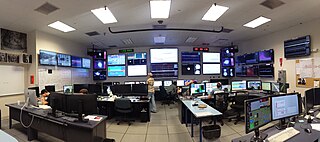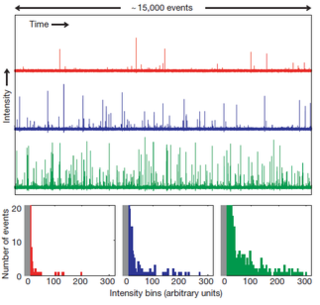
Ionization is the process by which an atom or a molecule acquires a negative or positive charge by gaining or losing electrons, often in conjunction with other chemical changes. The resulting electrically charged atom or molecule is called an ion. Ionization can result from the loss of an electron after collisions with subatomic particles, collisions with other atoms, molecules and ions, or through the interaction with electromagnetic radiation. Heterolytic bond cleavage and heterolytic substitution reactions can result in the formation of ion pairs. Ionization can occur through radioactive decay by the internal conversion process, in which an excited nucleus transfers its energy to one of the inner-shell electrons causing it to be ejected.
Spintronics, also known as spin electronics, is the study of the intrinsic spin of the electron and its associated magnetic moment, in addition to its fundamental electronic charge, in solid-state devices. The field of spintronics concerns spin-charge coupling in metallic systems; the analogous effects in insulators fall into the field of multiferroics.

The Laser Interferometer Gravitational-Wave Observatory (LIGO) is a large-scale physics experiment and observatory designed to detect cosmic gravitational waves and to develop gravitational-wave observations as an astronomical tool. Two large observatories were built in the United States with the aim of detecting gravitational waves by laser interferometry. These observatories use mirrors spaced four kilometers apart which are capable of detecting a change of less than one ten-thousandth the charge diameter of a proton.

In the philosophy of thermal and statistical physics, the Brownian ratchet or Feynman–Smoluchowski ratchet is an apparent perpetual motion machine of the second kind, first analysed in 1912 as a thought experiment by Polish physicist Marian Smoluchowski. It was popularised by American Nobel laureate physicist Richard Feynman in a physics lecture at the California Institute of Technology on May 11, 1962, during his Messenger Lectures series The Character of Physical Law in Cornell University in 1964 and in his text The Feynman Lectures on Physics as an illustration of the laws of thermodynamics. The simple machine, consisting of a tiny paddle wheel and a ratchet, appears to be an example of a Maxwell's demon, able to extract mechanical work from random fluctuations (heat) in a system at thermal equilibrium, in violation of the second law of thermodynamics. Detailed analysis by Feynman and others showed why it cannot actually do this.
Bart Andrew Kosko is a writer and professor of electrical engineering and law at the University of Southern California (USC). He is a researcher and popularizer of fuzzy logic, neural networks, and noise, and the author of several trade books and textbooks on these and related subjects of machine intelligence. He was awarded the 2022 Donald O. Hebb Award for neural learning by the International Neural Network Society.

Neuronal noise or neural noise refers to the random intrinsic electrical fluctuations within neuronal networks. These fluctuations are not associated with encoding a response to internal or external stimuli and can be from one to two orders of magnitude. Most noise commonly occurs below a voltage-threshold that is needed for an action potential to occur, but sometimes it can be present in the form of an action potential; for example, stochastic oscillations in pacemaker neurons in suprachiasmatic nucleus are partially responsible for the organization of circadian rhythms.
The gravitational wave background is a random background of gravitational waves permeating the Universe, which is detectable by gravitational-wave experiments, like pulsar timing arrays. The signal may be intrinsically random, like from stochastic processes in the early Universe, or may be produced by an incoherent superposition of a large number of weak independent unresolved gravitational-wave sources, like supermassive black-hole binaries. Detecting the gravitational wave background can provide information that is inaccessible by any other means about astrophysical source population, like hypothetical ancient supermassive black-hole binaries, and early Universe processes, like hypothetical primordial inflation and cosmic strings.
Spin pumping is the dynamical generation of pure spin current by the coherent precession of magnetic moments, which can efficiently inject spin from a magnetic material into an adjacent non-magnetic material. The non-magnetic material usually hosts the spin Hall effect that can convert the injected spin current into a charge voltage easy to detect. A spin pumping experiment typically requires electromagnetic irradiation to induce magnetic resonance, which converts energy and angular momenta from electromagnetic waves to magnetic dynamics and then to electrons, enabling the electronic detection of electromagnetic waves. The device operation of spin pumping can be regarded as the spintronic analog of a battery.
Kurt Wiesenfeld is an American physicist working primarily on non-linear dynamics. His works primarily concern stochastic resonance, spontaneous synchronization of coupled oscillators, and non-linear laser dynamics. Since 1987, he has been professor of physics at the Georgia Institute of Technology.
In physics, a quantum amplifier is an amplifier that uses quantum mechanical methods to amplify a signal; examples include the active elements of lasers and optical amplifiers.

The Landau–Zener formula is an analytic solution to the equations of motion governing the transition dynamics of a two-state quantum system, with a time-dependent Hamiltonian varying such that the energy separation of the two states is a linear function of time. The formula, giving the probability of a diabatic transition between the two energy states, was published separately by Lev Landau, Clarence Zener, Ernst Stueckelberg, and Ettore Majorana, in 1932.
Within quantum technology, a quantum sensor utilizes properties of quantum mechanics, such as quantum entanglement, quantum interference, and quantum state squeezing, which have optimized precision and beat current limits in sensor technology. The field of quantum sensing deals with the design and engineering of quantum sources and quantum measurements that are able to beat the performance of any classical strategy in a number of technological applications. This can be done with photonic systems or solid state systems.
Peter Hänggi is a theoretical physicist from Switzerland, Professor of Theoretical Physics at the University of Augsburg. He is best known for his original works on Brownian motion and the Brownian motor concept, stochastic resonance and dissipative systems. Other topics include, driven quantum tunneling, such as the discovery of coherent destruction of tunneling (CDT), phononics, relativistic statistical mechanics and the foundations of classical and quantum thermodynamics.
Stochastic resonance is a phenomenon that occurs in a threshold measurement system when an appropriate measure of information transfer is maximized in the presence of a non-zero level of stochastic input noise thereby lowering the response threshold; the system resonates at a particular noise level.
Luca Gammaitoni is a scientist in the area of noise and nonlinear dynamics. He is currently the Director of the Noise in Physical System Laboratory at the Physics Department of the Università di Perugia, in Italy.
Differential dynamic microscopy (DDM) is an optical technique that allows performing light scattering experiments by means of a simple optical microscope. DDM is suitable for typical soft materials such as for instance liquids or gels made of colloids, polymers and liquid crystals but also for biological materials like bacteria and cells.
Double ionization is a process of formation of doubly charged ions when laser radiation is exerted on neutral atoms or molecules. Double ionization is usually less probable than single-electron ionization. Two types of double ionization are distinguished: sequential and non-sequential.

Optical rogue waves are rare pulses of light analogous to rogue or freak ocean waves. The term optical rogue waves was coined to describe rare pulses of broadband light arising during the process of supercontinuum generation—a noise-sensitive nonlinear process in which extremely broadband radiation is generated from a narrowband input waveform—in nonlinear optical fiber. In this context, optical rogue waves are characterized by an anomalous surplus in energy at particular wavelengths or an unexpected peak power. These anomalous events have been shown to follow heavy-tailed statistics, also known as L-shaped statistics, fat-tailed statistics, or extreme-value statistics. These probability distributions are characterized by long tails: large outliers occur rarely, yet much more frequently than expected from Gaussian statistics and intuition. Such distributions also describe the probabilities of freak ocean waves and various phenomena in both the man-made and natural worlds. Despite their infrequency, rare events wield significant influence in many systems. Aside from the statistical similarities, light waves traveling in optical fibers are known to obey the similar mathematics as water waves traveling in the open ocean, supporting the analogy between oceanic rogue waves and their optical counterparts. More generally, research has exposed a number of different analogies between extreme events in optics and hydrodynamic systems. A key practical difference is that most optical experiments can be done with a table-top apparatus, offer a high degree of experimental control, and allow data to be acquired extremely rapidly. Consequently, optical rogue waves are attractive for experimental and theoretical research and have become a highly studied phenomenon. The particulars of the analogy between extreme waves in optics and hydrodynamics may vary depending on the context, but the existence of rare events and extreme statistics in wave-related phenomena are common ground.
Hyperuniform materials are characterized by an anomalous suppression of density fluctuations at large scales. More precisely, the vanishing of density fluctuations in the long-wave length limit distinguishes hyperuniform systems from typical gases, liquids, or amorphous solids. Examples of hyperuniformity include all perfect crystals, perfect quasicrystals, and exotic amorphous states of matter.
Levitation based inertial sensing is a new and rapidly growing technique for measuring linear acceleration, rotation and orientation of a body. Based on this technique, inertial sensors such as accelerometers and gyroscopes, enables ultra-sensitive inertial sensing. For example, the world's best accelerometer used in the LISA Pathfinder in-flight experiment is based on a levitation system which reaches a sensitivity of and noise of .





